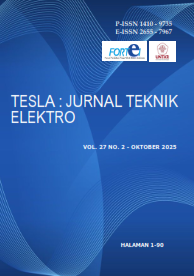PERFORMANCE STUDY OF OVERVOLTAGE CUTTING BY LIGHTNING ARRESTER DUE TO LIGHTNING INDUCTION
Main Article Content
Abstract
Lightning disturbances often cause induced overvoltages on 20 kV medium voltage distribution overhead lines, which can shorten equipment life and trigger power outages. This study aims to evaluate the cutting performance of two types of lightning arresters made of ceramic and polymer in reducing lightning-induced voltage surges through high-voltage impulse testing in the laboratory. The tests replicated standard impulse waves and were conducted in stages at 20 kV, 30 kV, 40 kV, and 50 kV levels, with each level repeated several times for data reliability. The main parameters analyzed included the measured peak voltage, response time (μs), and the cutting percentage compared to unprotected conditions, based on validated oscilloscope readings (time/div and volt/div). The results showed that both arresters reduced the induced voltage in most test scenarios, with the highest effectiveness occurring at 30 kV impulses. Quantitatively, ceramic arresters achieve a cutoff of 0.39–4.17 V (2.27–22.3%), while polymer arresters achieve 1.46–4.67 V (8.44–24.97%), and at 20 kV no significant cutoff is observed. In general, the performance of polymer lighting arresters is better than ceramic lighting arresters, which indicates the ability of polymer materials and housing designs to maintain lower residual voltages when facing fast transients
Abstrak
Gangguan petir seringkali menimbulkan tegangan lebih terinduksi pada saluran udara distribusi tegangan menengah 20 kV yang berakibat memperpendek umur peralatan dan memicu pemadaman listrik. Penelitian ini bertujuan mengevaluasi kinerja pemotongan dua tipe lightning arrester berbahan keramik dan berbahan polimer dalam mereduksi lonjakan tegangan akibat induksi petir melalui pengujian impuls tegangan tinggi di laboratorium. Pengujian mereplikasi gelombang impuls standar dan dilakukan bertingkat pada level 20 kV, 30 kV, 40 kV, dan 50 kV dimana setiap level diulang beberapa kali untuk reliabilitas data. Parameter utama yang dianalisis meliputi tegangan puncak terukur, respons waktu (μs), serta persentase pemotongan terhadap kondisi tanpa proteksi, berdasarkan pembacaan osiloskop yang telah divalidasi (time/div dan volt/div). Hasil menunjukkan kedua arrester menurunkan tegangan induksi pada sebagian besar skenario uji, dengan efektivitas tertinggi muncul pada impuls 30 kV. Secara kuantitatif, arrester keramik mencapai pemotongan 0,39–4,17 V (2,27–22,3%), sedangkan arrester polimer 1,46–4,67 V (8,44–24,97%) dan pada tegangan 20 kV tidak teramati pemotongan berarti. Secara umum kinerja lighting arrester polimer lebih baik dibandingkan lighting arrester berbahan keramik, yang mengindikasikan kemampuan material dan rancangan housing polimer untuk menjaga tegangan residual lebih rendah saat menghadapi transien cepat
Article Details

This work is licensed under a Creative Commons Attribution-ShareAlike 4.0 International License.
This work is licensed under a TESLA: Jurnal Teknik Elektro Creative Commons Attribution-ShareAlike 4.0 International License. 
References
[1] IEEE Standard 1410-2010, IEEE Guide for Improving the Lightning Performance of Electric Power Overhead Distribution Lines, 2010.
[2] IEC 60071-4, Insulation Coordination – Part 4: Guide to the Selection of Insulation Levels, 2019.
[3] F. Giraudet, “Line surge arresters: Applications, designs, trends, monitoring and recommendations,” INMR, 2017.
[4] B. Robben, “Reducing clearances by integration of externally gapped line arresters on HV transmission lines,” Siemens AG, 2019.
[5] B. G. Halasz et al., “Behavior of spark gaps with different gap distances,” IEEE Electrical Insulation Conference (EIC), 2017.
[6] L. I. C. Jimenez and M. Rock, “Surface breakdown voltage of creeping discharge spark gap using POM,” ICLP/SIPDA Conference Proceedings, 2021.
[7] P. Duan et al., “Evaluation of lightning-induced overvoltage on a 10 kV distribution line,” High Voltage, vol. 9, no. 2, pp. 356–366, 2024.
[8] L. Zhang et al., “Indirect lightning performance of 10-kV overhead distribution lines,” Frontiers in Energy Research, 2024.
[9] T. E. Tsovilis and Z. Topcagic, “DC overload behavior of varistor-based surge protective devices,” IEEE Transactions on Power Delivery, 2020.
[10] N. Novizon et al., “Power loss estimation of polymeric housing surge arrester using leakage current and temperature approach,” IOP Conference Series: Materials Science and Engineering, 2019.
[11] Z. Topcagic and T. E. Tsovilis, “Varistor electrical properties: Microstructural effects,” Elsevier Reference Module, 2020.
[12] IEC 60060-1:2010, High-Voltage Test Techniques – Part 1: General Definitions and Test Requirements, 2010.
[13] E. Kuffel, W. S. Zaengl, and J. Kuffel, High Voltage Engineering: Fundamentals, Butterworth-Heinemann, 2000.
[14] IEC 60071-1, Insulation Coordination – Part 1: Definitions, Principles, and Rules, 2019.
[15] P. Duan et al., “Evaluation of lightning-induced overvoltage on a 10 kV distribution line,” High Voltage, vol. 9, no. 2, pp. 356–366, 2024.
[16] N. Novizon et al., “Power loss estimation of polymeric housing surge arrester using leakage current and temperature approach,” IOP Conference Series: Materials Science and Engineering, 2019.
[17] Z. Topcagic and T. E. Tsovilis, “Varistor electrical properties: Microstructural effects,” Elsevier Reference Module, 2020.
[18] L. Zhang et al., “Indirect lightning performance of 10-kV overhead distribution lines,” Frontiers in Energy Research, 2024.
[19] IEC 60099-4, Surge Arresters – Part 4: Metal-Oxide Surge Arresters Without Gaps for A.C. Systems, 2019.
[20] L. I. C. Jimenez and M. Rock, “Measurements of surface breakdown voltage of creeping discharge spark air gap,” ICLP Proceedings, 2021.
[21] T. E. Tsovilis and Z. Topcagic, “DC overload behavior of low-voltage varistor-based surge protective devices,” IEEE Transactions on Power Delivery, 2020.
[22] IEC 60071-2, Insulation Coordination – Part 2: Application Guide, 2019



